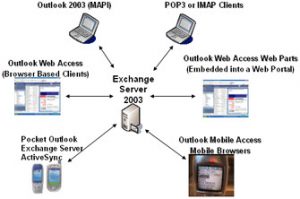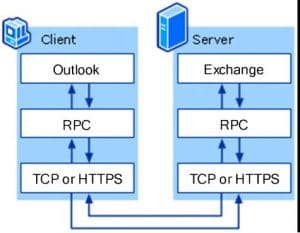In this article, we are going to learn about the different types of standard clients for Microsoft Exchange Systems and the way how it gets connected to the server.
Introduction:
 Microsoft was brilliant enough to predict the usage of Exchange system clients, eventually even the users started to rely completely on Outlook and Mobile Devices. The way most an Outlook users use the calendaring system is so dramatic that they even mark their lunch and tea sessions in the outlook calendars. Hence Microsoft came up with different clients for different requirements. Microsoft even started building clients for cross platforms. For example Mac OS and Android systems and they were successful. Let’s discuss the types of clients in detail.
Microsoft was brilliant enough to predict the usage of Exchange system clients, eventually even the users started to rely completely on Outlook and Mobile Devices. The way most an Outlook users use the calendaring system is so dramatic that they even mark their lunch and tea sessions in the outlook calendars. Hence Microsoft came up with different clients for different requirements. Microsoft even started building clients for cross platforms. For example Mac OS and Android systems and they were successful. Let’s discuss the types of clients in detail.
Types of Exchange Clients:
There are 6 major clients that are available for usage with Microsoft Exchange Systems. These clients have different versions and each version will have its own advantages, benefits. The major client for Microsoft Exchange is Outlook. Hence Microsoft will release a newer version of Outlook on every new version of Exchange release. This is for matching the new protocols, new concepts that has integrated with the Exchange. For example, Outlook Anywhere was introduced in 2007, so Outlook 2003 will not support the later versions of Exchange mailboxes. Now let’s see the types of clients.
- Microsoft Outlook
- Outlook Web App (OWA)
- Outlook 2011(Outlook for Mac)
- Outlook for Mobile
- OWA for Mobile ( iOS and Android)
- IMAP & POP3 Clients
Clients & Protocols:

Outlook Web App: Outlook Web App in short OWA. Microsoft is now keen in giving a rich look to the OWA and tries to integrate all the Outlook functionalities in OWA, but still OWA lacks certain features that only Outlook can give. OWA works with the help of Virtual Directories and IIS (Default Website) that gets installed along with Exchange Installation. There is no much attention required for OWA, since it is not a software depended client. It directly interacts with IIS and Exchange systems, however every version of Exchange gives a new and richer look for OWA. The Latest OWA is capable of working in all modern browsers that includes mobile browsers as well.
Conclusion:
The above discussed clients are purely for conventional Windows based computers and Laptops, which even support orphaned OST file recovery or PST file Recovery. We do have other clients that supports Non-Windows platform, we will discuss those in detail in the next part.
Author Introduction:
Sophia Mao is a data recovery expert in DataNumen, Inc., which is the world leader in data recovery technologies, including repair pst email error and word recovery software products. For more information visit www.datanumen.com